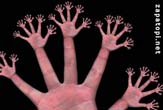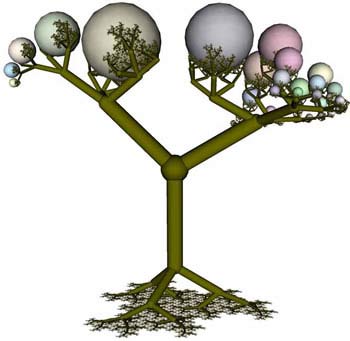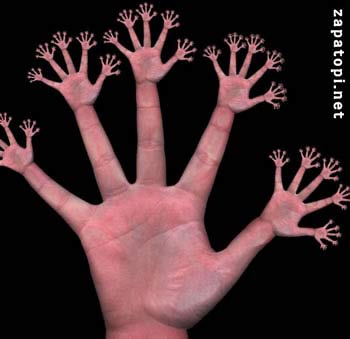Freaky Fractal Fingers, Fingers, Fingers

In his 1941 novel Methuselah'sChildren, science fiction author RobertHeinlein writes about a humanbabymodifiedbyanalienrace. The baby was given the following "improvements" (among others):
"...it's body architecture has been redesigned for greater efficiency, our useless simian hangovers have been left out, and its organs have been rearranged in a more sensible fashion. You can't say it's not human, for it is... an improved model. Take that extra appendage at the wrist. That's another hand, a miniature one... backed up by a microscopic eye. You can see how useful that would be, once you got used to the idea."
Heinlein also pursued similar ideas a bit earlier in his 1940 novella Waldo, his story about, well, waldoes - he originated the concept as well as the term. A waldo is a remote manipulator that mimics human motion at larger and smaller scales. For example, waldoes that looked like mechanical hands that were six feet across could bend steel girders, as well as "tiny pixy hands, an inch across" used for miniature work. In his later work Time Enough for Love, he wrote about "ultramicrominiature waldoes" that could be used for gene surgery.
Roboticist Hans Moravec conceived of a more "fractal" version of this idea; a "bush robot" (also called a "Fractal branching ultra-dexterous robot") that literally had manipulators on its manipulators on its manipulators... you get the idea.

(Moravec Bush Robot simulation)
Moravec states that this idea is at least a half-century from being practical; among the advances required are
- Computational power increased at least a millionfold in density
- Capacity to build mechanical structures over the entire range of scales
- Scalable high-power actuators
- Scalable high-density power distribution and storage
- High-strength materials.
Science fiction author Ken MacLeod,in Engine City, wrote about a kind of alien tarantula that was directlyinspired by Moravec's work:
...At the end of each appendage's eight fingers there are tinier appendages, eight of them, and these fingers' fingerlets are what open out to grasp the microscopic frictions of the pane... (Read more about the alien tarantula)
For a bizarre illustration of both Heinlein's and Moravec's ideas that is perfectly suited to the Halloween season, see the Dactyl Fractal Zoom at Zapato Productions. A static sample is shown below.
Sign up for the Live Science daily newsletter now
Get the world’s most fascinating discoveries delivered straight to your inbox.

(Dactyl Fractal: Click to Zoom)
Find out more about Robert Heinlein's waldoes;for a different vision of a robotic manipulator, see TheRobot Blanket Project.Read detailsabout bushrobots. Thanks to PosthumanBlues for parts of this story.
(This Science Fiction in the News story used with permission from Technovelgy.com - where science meets fiction.)










